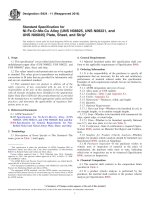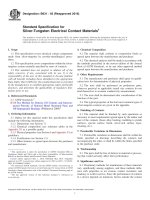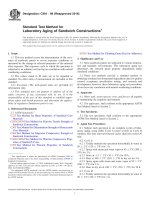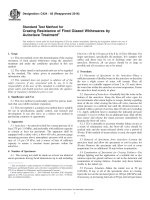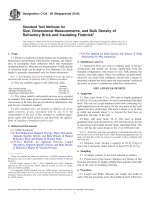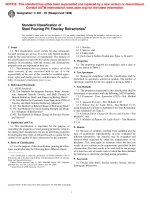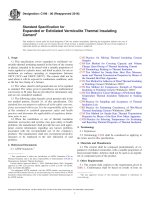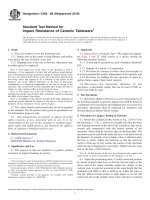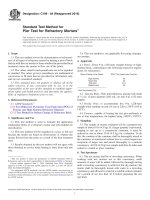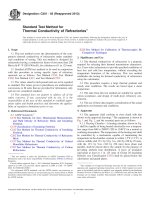Astm c 424 93 (2016)
Bạn đang xem bản rút gọn của tài liệu. Xem và tải ngay bản đầy đủ của tài liệu tại đây (63.39 KB, 2 trang )
Designation: C424 − 93 (Reapproved 2016)
Standard Test Method for
Crazing Resistance of Fired Glazed Whitewares by
Autoclave Treatment1
This standard is issued under the fixed designation C424; the number immediately following the designation indicates the year of
original adoption or, in the case of revision, the year of last revision. A number in parentheses indicates the year of last reapproval. A
superscript epsilon (´) indicates an editorial change since the last revision or reapproval.
1. Scope
6 by 6 in. (152 by 152 mm) or 6 by 8 in. (152 by 200 mm). For
larger specimens, specifically tile products, five samples will
suffice and these may be cut to facilitate entry into the
autoclave. However, all cut pieces should be as large as
possible and all cut pieces are to be tested.
1.1 This test method covers the determination of the crazing
resistance of fired glazed whitewares using the autoclave
treatment and under the conditions specified in this test
method.
1.2 The values stated in inch-pound units are to be regarded
as the standard. The values given in parentheses are for
information only.
1.3 This standard does not purport to address all of the
safety concerns, if any, associated with its use. It is the
responsibility of the user of this standard to establish appropriate safety and health practices and determine the applicability of regulatory limitations prior to use.
5. Procedure
5.1 Placement of Specimens in the Autoclave—Place a
sufficient amount of distilled water in the autoclave so that after
the test a slight excess of water will remain. Place all
specimens on a suitable support at least 2 in. (51 mm) above
the water line within the autoclave at room temperature. Fasten
the autoclave head securely in place.
5.2 Operation of Autoclave—Gradually heat the water in the
bottom of the autoclave. Keep the blow-off valve open for
several minutes after steam begins to escape, thereby expelling
most of the air. After closing the blow-off valve, increase the
steam pressure at a uniform rate until the desired pressure is
reached within a period of not less than 45 min nor exceeding
1 h. Apply sufficient heat to maintain the indicated pressure
constant (62 psi (14 kPa)) for an additional hour. Shut off the
heat source and release the steam pressure immediately by
opening the blow-off valve.
5.2.1 If it is desirable to ascertain whether failure occurs as
a result of rehydration only, the blow-off valve should be
cracked only and the steam released slowly over a period of
30 min. If this method of steam release is used, the report shall
so state.
2. Significance and Use
2.1 This test method is particularly useful for porous materials that can exhibit moisture expansion.
2.2 This test method is a primary test method that is suitable
for use in specifications, quality control, and research and
development. It can also serve as a referee test method in
purchasing contracts or agreements.
3. Apparatus
3.1 Autoclave—An autoclave built for a steam pressure of at
least 275 psi (1.9 MPa), and preferably with sufficient capacity
to contain at least ten specimens. The apparatus shall be
equipped with a safety valve, a blow-off valve, pressure gauge
measuring pressure above atmospheric pressure with an accuracy of 65 psi (34 kPa), and a source of heat of sufficient
capacity to ensure a constant steam pressure within the
autoclave.
5.3 Removal of Specimens from Autoclave—Loosen the
autoclave head and allow the specimens to cool in place for
30 min. Remove the specimens and allow to cool at room
temperature for an additional 30 min before examination.
4. Number of Specimens
5.4 Examination of Specimens for Crazing Failures—Use
oblique lighting and the application of a suitable ink or dye
solution upon the glazed surfaces to aid in the detection and
examination of crazing failures. Consider only those failures
visible to the naked eye.
4.1 The crazing test shall be made on at least ten identical
uncut specimens having facial dimensions up to and including
1
This test method is under jurisdiction of ASTM Committee C21 on Ceramic
Whitewares and Related Products and is the direct responsibility of Subcommittee
C21.03 on Methods for Whitewares and Environmental Concerns.
Current edition approved Nov. 1, 2016. Published November 2016. Originally
approved in 1958. Last previous edition approved in 2012 as C424 – 93 (2012).
DOI: 10.1520/C0424-93R16.
5.5 Pressure Schedule—Make the initial test at 50 psi
(345 kPa). If any or all of the specimens show no crazing,
repeat the test on the uncrazed pieces at 100 psi (689 kPa) and,
if necessary, at increasing intervals of 50 psi until all specimens
Copyright © ASTM International, 100 Barr Harbor Drive, PO Box C700, West Conshohocken, PA 19428-2959. United States
1
C424 − 93 (2016)
have crazed or until a pressure of 250 psi (1.7 MPa) has been
reached. Successive tests shall be separated by a time interval
not exceeding 24 h. If it is desired to use this procedure in
conjunction with a product specification, the test may be
limited to one or more of these specified pressures.
6.1.5 Average failure pressure, calculated by multiplying
each pressure by the number of specimens failing at that
pressure and dividing the sum of these products by the total
number of pieces tested (specimens having withstood the
200-psi (1.4-MPa) test shall be said to have failed at 250 psi
(1.7 MPa) for the purpose of calculation), and
6.1.6 Time consumed for steam release, if the pressure was
not released immediately at the conclusion of each test.
6. Report
6.1 Report the following information:
6.1.1 Identification of specimens.
6.1.2 Number of specimens tested.
6.1.3 Identification of ink or dye solutions used in examination of specimens.
6.1.4 Table listing each steam pressure, in pounds per
square inch (or pascals), with the number of specimens failing
at each pressure,
7. Precision and Bias
7.1 Duplicate determinations should not differ by more than
50 psi (0.34 MPa).
7.2 Bias has not been determined.
8. Keywords
8.1 autoclave; crazing; crazing resistance
ASTM International takes no position respecting the validity of any patent rights asserted in connection with any item mentioned
in this standard. Users of this standard are expressly advised that determination of the validity of any such patent rights, and the risk
of infringement of such rights, are entirely their own responsibility.
This standard is subject to revision at any time by the responsible technical committee and must be reviewed every five years and
if not revised, either reapproved or withdrawn. Your comments are invited either for revision of this standard or for additional standards
and should be addressed to ASTM International Headquarters. Your comments will receive careful consideration at a meeting of the
responsible technical committee, which you may attend. If you feel that your comments have not received a fair hearing you should
make your views known to the ASTM Committee on Standards, at the address shown below.
This standard is copyrighted by ASTM International, 100 Barr Harbor Drive, PO Box C700, West Conshohocken, PA 19428-2959,
United States. Individual reprints (single or multiple copies) of this standard may be obtained by contacting ASTM at the above
address or at 610-832-9585 (phone), 610-832-9555 (fax), or (e-mail); or through the ASTM website
(www.astm.org). Permission rights to photocopy the standard may also be secured from the Copyright Clearance Center, 222
Rosewood Drive, Danvers, MA 01923, Tel: (978) 646-2600; />
2
